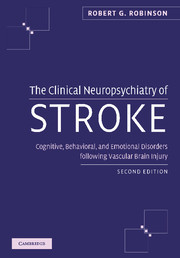Description
The Clinical Neuropsychiatry of Stroke (2nd Ed., Revised edition)
Cognitive, Behavioral and Emotional Disorders following Vascular Brain Injury
Author: Robinson Robert G.
This fully revised second edition covers the range of neuropsychiatric syndromes associated with stroke.
Language: English
Subject for The Clinical Neuropsychiatry of Stroke:
Approximative price 85.24 €
In Print (Delivery period: 14 days).
Add to cart
The Clinical Neuropsychiatry of Stroke
Publication date: 09-2012
Support: Print on demand
Publication date: 09-2012
Support: Print on demand
Approximative price 213.48 €
Subject to availability at the publisher.
Add to cart
The clinical neuropsychiatry of stroke: cognitive, behavioral and emotional disorders following vascular brain injury, (2nd Ed.)
Publication date: 02-2006
484 p. · 17.8x25.2 cm · Hardback
Publication date: 02-2006
484 p. · 17.8x25.2 cm · Hardback
Description
/li>Contents
/li>
This second edition covers the range of neuropsychiatric syndromes associated with stroke, including cognitive, emotional and behavioural disorders such as depression, anxiety and psychosis. There is growing recognition among a wide range of clinicians and allied healthcare staff that post-stroke neuropsychiatric syndromes are common and serious. Such complications can have a negative impact on recovery and even survival; however, there is now evidence suggesting that pre-emptive therapeutic intervention in high-risk patient groups can prevent the initial onset of the conditions. This opportunity for primary prevention marks a huge advance in the management of this patient population.
1. Recent trends in the epidemiology of stroke; 2. Historical perspective; 3. Brain organization and cerebral basis of emotion; 4. Vascular anatomy and classification of stroke; 5. Diagnosis of depression; 6. Prevalence of depressive disorders; 7. Phenomenology and specificity of depressive disorders; 8. Natural course of depression; 9. Delayed-onset depression (proofed); 10. Relationship to lesion location; 11. Relationship of depression to cerebral dominance and structural asymmetries; 12. Relationship of depression to bilateral hemisphere brain injury; 13. Relationship of depression to physical impairment; 14. Relationship to cognitive impairment and treatment; 15. Relationship of aphasia to depression; 16. Relationship of depression to social functioning; 17. Relationship to premorbid risk factors; 18. Mortality and treatment; 19. Suicidal thoughts and plans; 20. Biological markers; 21. Mechanisms of poststroke depression; 22. Treatment of poststroke depression; 23. Prevention of poststroke depression; 24. Prevalence and clinical symptoms; 25. Clinical and lesion correlates of poststroke mania; 26. Bipolar disorder following stroke; 27. Mechanism of mania following stroke; 28. Treatment of mania following stroke; 29. Prevalence and specificity of clinical symptoms; 30. Clinical and lesion correlates; 31. Longitudinal course; 32. Relationship of anxiety to outcome; 33. Mechanism and treatment of poststroke anxiety disorder; 34. Psychosis; 35. Anosognosia and denial of illness; 36. Catastrophic reaction; 37. Apathy; 38. Disturbance of prosody; 39. Irritability and aggression; 40. Pathological laughing and crying; 41. Summary and future directions.
© 2024 LAVOISIER S.A.S.




